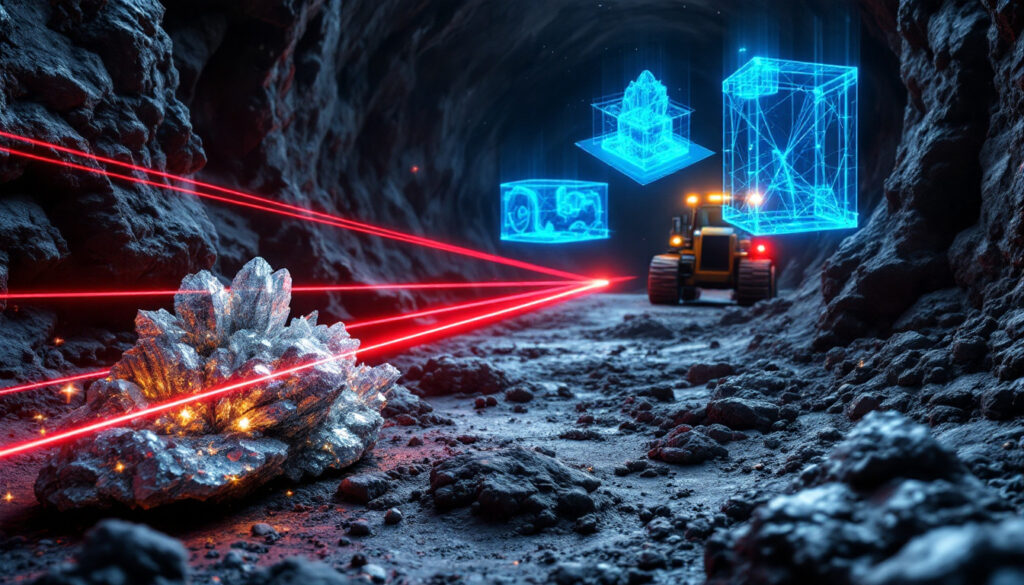Military Metals Launches Trojárová LiDAR Survey: Strategic Antimony Exploration in Slovakia
Military Metals (CSE:MILI) has officially launched its groundbreaking LiDAR survey at the Trojárová antimony-gold deposit in Slovakia, marking a significant advancement in the company's strategic metal exploration efforts. This technologically advanced survey represents a critical step in developing what could become one of Europe's most strategically important antimony resources amid record-high prices and growing concerns about Western supply chain security.
What is the Trojárová LiDAR Survey?
Understanding LiDAR Technology in Mining Exploration
Laser-imaging, detection and ranging (LiDAR) technology represents a revolutionary approach to mineral exploration, particularly at historically mined sites like Trojárová. The technology employs pulsed laser beams to create precise three-dimensional maps of both surface features and underground workings with remarkable centimeter-level accuracy.
"LiDAR technology gives us unprecedented insight into historical mining operations that traditional surveying methods simply cannot match," explains Military Metals CEO Scott Eldridge. "This level of precision is absolutely critical when we're dealing with high-value antimony deposits where even small targeting errors can significantly impact exploration efficiency."
The survey specifically aims to document historical underground workings in extraordinary detail, capturing not only the spatial dimensions of existing tunnels and shafts but also precisely mapping historical sample locations. This information is invaluable for verifying historical mineralization reports and identifying zones of potentially overlooked high-grade antimony.
The collected data will be integrated into a comprehensive three-dimensional deposit model being developed by SLR Consulting, one of the mining industry's premier technical advisors. This model will incorporate historical mining records, geological mapping, and the new LiDAR data to create what promises to be the most detailed visualization of the Trojárová deposit ever produced.
Timeline and Implementation
The Trojárová LiDAR survey officially commenced in April 2025 and is expected to conclude within one week of announcement. This remarkably efficient timeline demonstrates Military Metals' commitment to rapid advancement of this strategic asset.
Concurrent with the LiDAR survey, technical teams are collecting over 20kg of mineralized material specifically for the development of custom antimony analytical standards. This often-overlooked aspect of exploration is crucial for ensuring laboratory accuracy when analyzing future drill samples, as antimony requires specialized analytical procedures that standard precious metal assay methods may not adequately capture.
The survey results will directly inform the company's upcoming drilling program, which aims to validate historical resource estimates suggesting the presence of high-grade antimony mineralization averaging 2.5-3.2% Sb with associated gold values of 1.2-1.8 g/t. These grades, if confirmed, would place Trojárová among the higher-grade antimony deposits globally available to Western markets.
Why is the Trojárová Project Strategically Important?
Antimony as a Critical Strategic Metal
Antimony has recently captured significant attention from Western governments and defense contractors as prices have skyrocketed to unprecedented levels. Current antimony prices have reached all-time highs of US$59,800 (A$94,614) per metric tonne, representing a 187% increase since January 2023.
This dramatic price surge reflects antimony's classification as a critical mineral by the United States, European Union, Canada, and Australia due to its concentrated supply chains and irreplaceable applications. China currently controls approximately 53% of global antimony production and 80% of refining capacity, creating a strategic vulnerability that Western nations are increasingly seeking to address.
"What many investors don't yet recognize is that antimony isn't just another industrial metal – it's absolutely irreplaceable in several defense applications," notes defense metals analyst Martin Kovács. "When you consider that every tank, aircraft, and missile system requires antimony components, the current supply concentration becomes a genuine national security concern for NATO countries."
Antimony's critical applications include:
- Flame retardants for military vehicles, aircraft, and protective equipment
- Hardening agents for ammunition and armor-piercing projectiles
- Battery technologies, including emerging liquid metal batteries
- Infrared sensors and night vision devices
- Semiconductor components for guidance systems
European Defense Industry Connection
The strategic importance of the Trojárová project is significantly amplified by its location within the European Union at a time when European defense spending is experiencing unprecedented growth. Following recent geopolitical developments, European NATO members have committed to increasing defense expenditures to at least 2% of GDP, representing an additional €350 billion in military spending over the next five years.
European defense manufacturers are particularly concerned about geopolitical supply chain challenges that could disrupt production. Antimony represents a critical weak point in this system. The EU's Strategic Autonomy initiative explicitly identifies domestically sourced strategic minerals as a key priority, creating a potentially captive market for European antimony producers.
Military Metals' strategic positioning aligns perfectly with these developments, as European defense contractors increasingly seek to secure supply agreements with Western-aligned producers of critical minerals. Industry analysts suggest that European defense manufacturers may be willing to pay significant premiums for domestically sourced antimony to reduce geopolitical supply risks.
Where is the Trojárová Project Located?
Strategic Position in Slovakia
The Trojárová antimony-gold project occupies a highly advantageous position in Western Slovakia, just 30 kilometers northeast of Bratislava, the nation's capital and an important manufacturing center. This location provides exceptional logistical advantages, including:
- Proximity to major European transportation networks
- Access to skilled mining labor force
- Located within 500km of major European defense manufacturing centers
- Stable EU jurisdiction with clear mining regulations
Geologically, the project sits on trend with and likely represents the continuation of the historical Pezinok Antimony-Gold Mine, which operated successfully for several decades, producing high-grade antimony and associated gold. Historical mining operations at Pezinok reportedly recovered over 20,000 tonnes of antimony and 1.5 tonnes of gold before closure in the early 1990s due to economic factors rather than resource depletion.
Regional Geological Context
The Trojárová deposit is situated within the Malé Karpaty (Little Carpathians) metallogenic belt, a geological region known for its polymetallic mineral endowment. The mineralization occurs primarily as stibnite (antimony sulfide) within quartz veins and shear zones hosted in metamorphic rocks.
What makes this geological setting particularly attractive is the consistent association of antimony with gold, creating potential for valuable by-product credits that could significantly enhance project economics. Historical sampling indicates gold grades ranging from 1.2 to 3.5 g/t in antimony-rich zones, with some selective samples reportedly exceeding 10 g/t Au.
"The Malé Karpaty metallogenic belt has been significantly underexplored using modern techniques," notes Dr. Jana Vršková, consulting geologist for the project. "Our preliminary work suggests the antimony-gold system may be much more extensive than historically documented, with potential for discovering additional mineralized zones at depth and along strike."
Who is Military Metals?
Company Background and Focus
Military Metals (CSE:MILI) is a British Columbia-based mineral exploration company that has strategically positioned itself at the intersection of the critical minerals race and defense applications. Led by CEO Scott Eldridge, the company has pursued an aggressive acquisition strategy focused on antimony and other strategic metals essential to Western defense and industrial applications.
The company's portfolio includes:
- Trojárová Antimony-Gold Project (Slovakia)
- Medvedi-Potok Tin Project (Slovakia)
- Last Chance Antimony-Gold Property (Nevada, USA)
Military Metals has assembled a technical team with specific expertise in antimony metallurgy and processing, addressing a significant knowledge gap in the Western mining sector. The company recently completed a successful appearance at the 2025 PDAC convention, where it reported "overwhelming interest" from both investors and potential strategic partners in the defense sector.
Strategic Vision and Market Position
Military Metals has articulated a clear strategic vision focused on becoming a premier Western supplier of critical defense minerals. This strategy appears well-timed given the current geopolitical emphasis on supply chain security and domestic sourcing of strategic materials.
"The fragility of antimony supply chains represents both a significant national security vulnerability and an exceptional opportunity for companies positioned to address it," explained CEO Scott Eldridge. "At Military Metals, we've specifically targeted assets that can be advanced rapidly to help address critical supply gaps for Western defense manufacturers."
The company's market capitalization of approximately $24 million (as of April 2025) potentially represents a significant discount to the strategic value of its antimony assets, particularly considering current record-high prices and the strategic premium that may be attached to Western antimony sources. For investors seeking mining investment insights, antimony projects offer unique exposure to defense sector demand drivers.
How Does This Project Support Western Supply Chain Security?
Reducing Dependency on Foreign Antimony Sources
The Trojárová project represents one of only a handful of advanced antimony exploration projects within Western-aligned nations. Given China's dominance of global antimony production (53%) and refining (80%), new Western sources have become a strategic priority for both governments and defense contractors.
The EU's Critical Raw Materials Act specifically identifies antimony as a priority mineral, with targets to develop domestic European production for at least 10% of annual consumption by 2030. The Trojárová project could potentially contribute significantly to this goal, providing a secure source within EU borders.
Several major Western defense contractors have reportedly initiated discussions with potential antimony producers regarding secure supply agreements, with indications that premium pricing may be available for domestically produced antimony that meets stringent quality specifications. According to recent underground survey results, the project shows exceptional promise.
Quality Assurance and Development Timeline
Military Metals' development of custom antimony analytical standards demonstrates a sophisticated understanding of the technical challenges associated with antimony production. Antimony presents unique metallurgical challenges, and the company's focus on quality control from the earliest exploration stages indicates a commitment to producing a product that will meet the exacting standards of defense applications.
The company's anticipated development timeline suggests potential for preliminary resource definition within 12-18 months, followed by metallurgical testing and preliminary economic assessment. This accelerated timeline reflects both the strategic urgency of developing Western antimony sources and the advantage of building upon historical exploration data.
FAQ About the Trojárová Project and Antimony Market
What is antimony used for in defense applications?
Antimony serves multiple critical defense functions, including:
- As a hardening agent in lead alloys used for ammunition and ballistics
- Essential component in flame-retardant materials protecting military vehicles, aircraft, and personnel
- Used in infrared detection equipment, including night-vision technology
- Component in specialized semiconductor applications for guidance systems
- Alloying element in certain specialized armor materials
Why are antimony prices reaching record highs?
The unprecedented price surge in antimony (currently US$59,800/tonne) reflects several converging factors:
- Chinese export restrictions and production limitations
- Increased stockpiling by defense contractors and governments
- Growing recognition of supply vulnerabilities in Western defense sectors
- Limited development pipeline of new antimony projects
- Technical challenges in substituting antimony in critical applications
Analysts project continued strong pricing, with potential for further increases as defense spending accelerates globally and strategic stockpiling continues.
What advantages does the Trojárová location offer?
The project's location provides several strategic advantages:
- Situated within EU borders, aligning with European strategic autonomy initiatives
- Close proximity to European defense manufacturing centers in Germany, France, and Italy
- Access to excellent infrastructure, including power, water, and transportation
- Location in Slovakia provides a stable mining jurisdiction with clear permitting pathways
- Historical mining expertise and skilled workforce available locally
How does the LiDAR survey enhance exploration efficiency?
The LiDAR technology employed at Trojárová offers several critical advantages:
- Provides centimeter-level accuracy in mapping historical workings
- Enables 3D visualization of complex underground structures
- Significantly reduces drilling risks by identifying existing excavations
- Allows precise correlation of historical sample locations with modern exploration
- Contributes to more accurate resource modeling and estimation
- Reduces overall exploration costs by optimizing drill targeting
This application of advanced technology to antimony exploration represents Military Metals' commitment to employing cutting-edge methods to accelerate the development of this strategically vital resource. The company's implementation of digital innovation in mining techniques like LiDAR represents an important example of how transformative mining practices are reshaping the industry. According to Military Metals' recent technical report, these innovations are crucial to maximizing the potential of this strategic resource.
Want to Identify the Next Major Mineral Discovery Before the Market?
Discovery Alert's proprietary Discovery IQ model delivers instant notifications on significant ASX mineral discoveries, enabling subscribers to act quickly on potentially transformative opportunities similar to those mentioned in this article. Explore our dedicated discoveries page to understand how early identification of major mineral finds can lead to exceptional investment returns.




